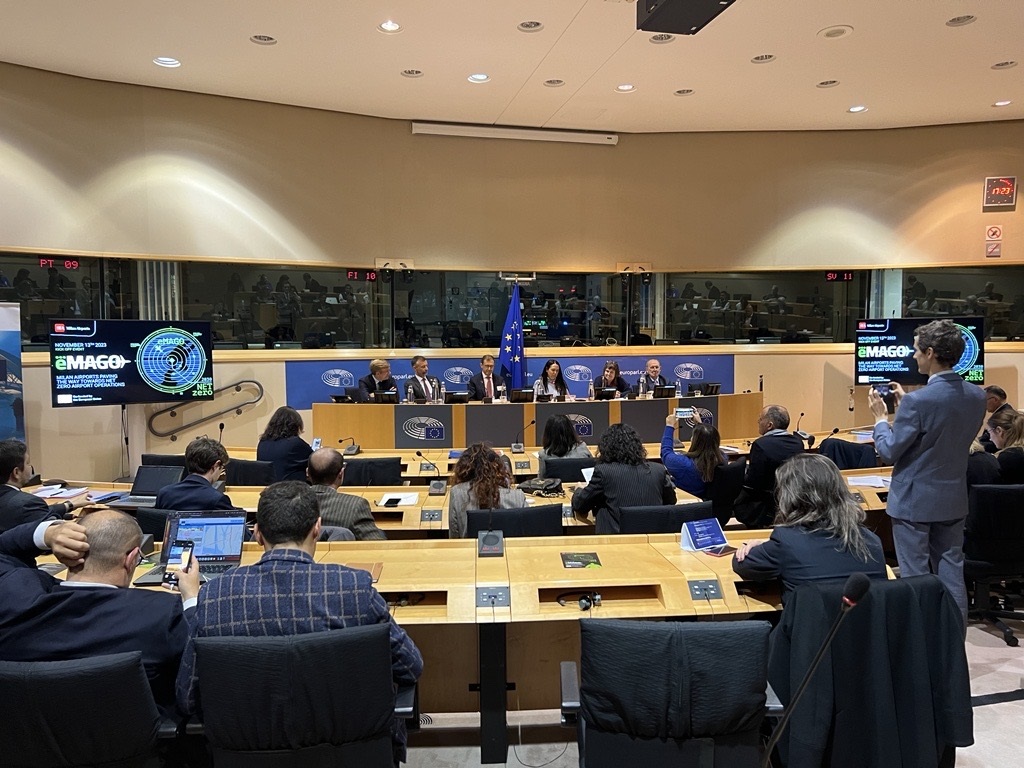December 2023
Airports are often the entry and exit points of the EU. What, then, could their contribution be to the green transport corridors in Europe? This question CINEA (the European agency that focuses on infrastructure and climate) asked the Horizon 2020 projects. During the eMago kick-off conference in December 2023, TULIPS and other H2020 projects talked about their link with green transport corridors and about possible cross-fertilisation between projects.
Making European transport networks more sustainable
Europe is in the middle of a major transformation towards becoming a climate neutral continent by 2050. Within this ambition lives the challenge to preserve the benefits and growth opportunities from efficient and connected European networks on the one side while drastically reducing their externalities on the other. Ambitions to connect the continent in a sustainable manner always existed, yet the European Green Deal (EGD) has now put them on the forefront of the political agenda.
Drastic reduction of greenhouse gas emissions
One of the strategic objectives of the EU Green Deal is the drastic reduction of GHG emissions from the transport sector that stretches over the continent supporting its social and economic connectedness. While the social benefits of sustaining an efficient Network are huge so is its demand for energy and the emissions that are traditionally linked to its consumption.
Nine major European transport corridors
Related decarbonising requirements articulated through the EU Green Deal can benefit from the governance structures established for the continent’s main transport corridors following the initial regulation of the Trans-European Transport Network (TEN-T) in 2013. At this stage the Commission governs the constant improvement of nine major transport corridors via which the majority of freight and passengers are transported at least on parts of their journey across the continent.
Revision of the TEN-T Regulation in line with Green Deal
The TEN-T regulation is currently being reviewed partially with the ambition to integrate sustainability matters in line with the objectives of the EGD. This approach follows the striking logic that if the continent manages to decarbonise the main corridors, then efforts will intrinsically affect a large quantity of transports emissions currently adding negatively to climate change.
Contribution of airports to green and connected transport corridors
In this context the Kick-off from the eMago project raised an interesting discussion on the role of airports in the revised version of the TEN-T regulation. While the TEN-T Network was very active on connecting and coordinating the pan-European road and rail connections, the integration of airports in the network remained comparably less articulated. To prevent this circumstance from being translated into the considerations for the decarbonising the Network, the European Climate, Infrastructure and Environment Executive Agency (CINEA) now encourages aviation related projects, funded through the Horizon Europe programme, the Connecting Europe Facility (CEF) and the Alternative Fuels Infrastructure Facility (AFIF), to indicate useful contributions from their projects to the objective of green and connected Transport corridors across the EU.

Discussion panels at eMago kick off
With high representatives from CINEA and the TEN-T Network two exciting Panels were held during the eMago Kick-off covering “new tools for airport’s decarbonisation” and “sustainable airports of tomorrow”.
Airports as first and last mile
From a Network perspectives Airports, predominantly serve as entry and exit points into the EU or as fast transport links within the EU. Air transport also has the capacity to substitute other modes of transport adding to improved interoperability and the overall resilience of the network. As designated entry and exit points the larger EU airports are located on the main transport corridors, and must thus be considered as the first and the last mile for the transport of passengers and freight along those corridors.
Participation of airports in Horizon 2020 projects
There are numerous corridor related airports involved in the currently funded projects. Each of them with an exciting strategy to become carbon neutral by 2030 and beyond. Within the TULIPS and the eMago projects, for example, Schiphol and Malpensa Airport represent the two endpoints for larger aviation capacities of the Rhine-Alpine Corridor.
Cross-fertilisation between Horizon 2020 projects
During the eMago kick-off event first discussions were held on opportunities to increase the cross-fertilisation amongst the projects under the perspective of contributors to green transport corridors and ultimately a climate neutral continent by 2050.
Opportunities towards mutual recommendations
An early area of common ground is the use of hydrogen in the airports ground operations. TULIPS is now assessing opportunities to collaborate with additional projects from the H2020 Cluster of green airports and ports for the benefit of mutual recommendations towards the role of airports in connected, efficient and green Transport corridors across the EU.
